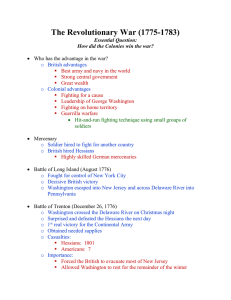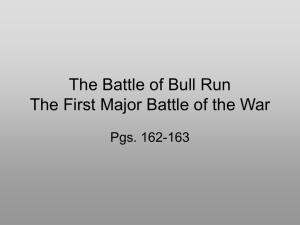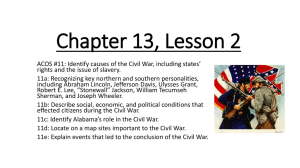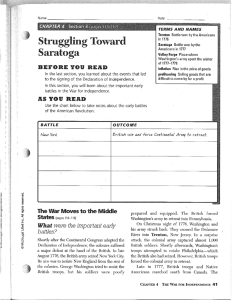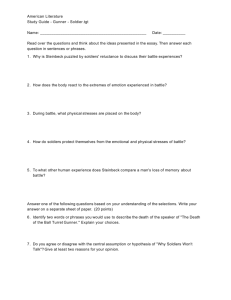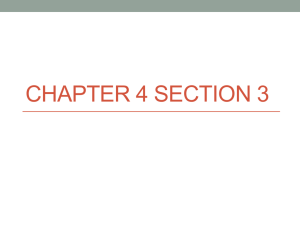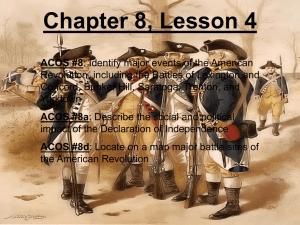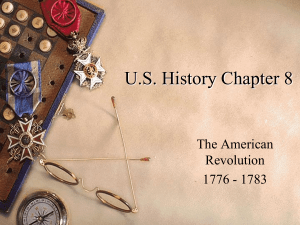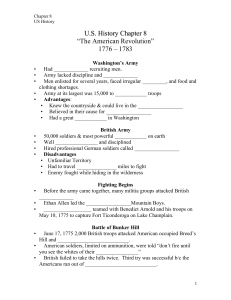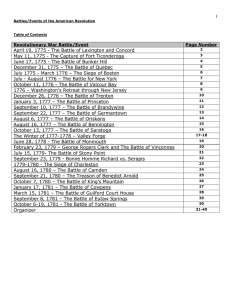American Revolution: Overthrow of a Monarch
advertisement
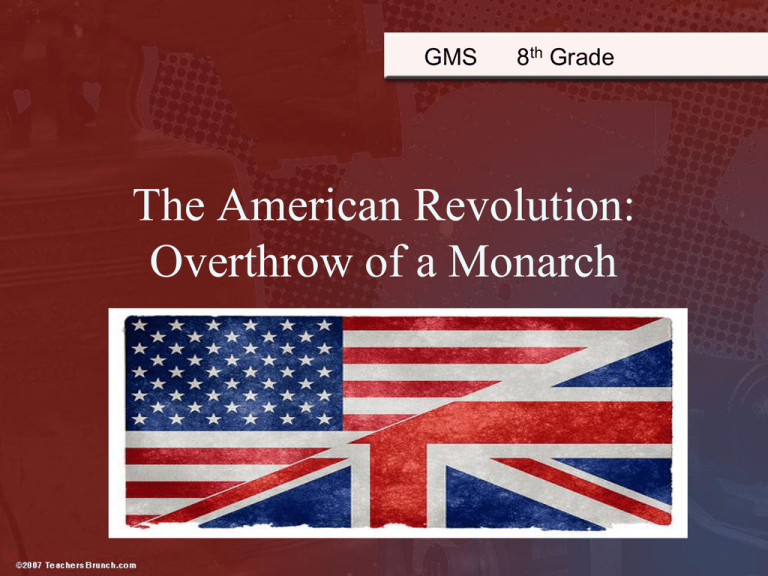
GMS 8th Grade The American Revolution: Overthrow of a Monarch The Declaration of Independence • Written by Thomas Jefferson • It is the “Birth Certificate of the United States” • Document listed rights and grievances against King George III • 4 parts 1. Preamble 2. Declaration of rights (Natural Rights) 3. List of Grievances 4. Resolution The Declaration of Independence • John Hancock first to sign in large print • Anyone who signed it and was caught would be hanged • “We must all now hang together, or most assuredly we will all hang separately." —Benjamin Franklin • Traitor- person who betrays his/her country Hancock Choosing Sides • Patriots – Supported the Revolution • Loyalists – Americans who supported the King • Red Coats/ Lobsterbacks – British Army Revolutionary Armies – The British • British Army most powerful in world • Also well-equipped with weapons • Highly trained and disciplined for war on land or high seas • Hired mercenaries from GermanyHessians Continental Armies – The Americans • Continental Army- army established by the Second Continental Congress to fight the British • Knew lay of the land • Used weapons appropriate for landscape • Wore pieces of different uniforms • Brown army clothing British Advantages • Well-equipped • Disciplined • Strongest navy • Professionally trained Army: 50,000 troops plus 30,000 mercenaries; • Experience British Disadvantages • Logistics of moving soldiers and supplies • Lack of British taxpayer support for the war • Poor leadership Lord George Germain American Advantages • Accuracy of the rifle • Knowledge of the land • Guerilla (hit and run) warfare tactics • Superb command (Washington) • Strong sense of patriotism • Motivated by hatred of the English, the French aided the colonists (allies) American Disadvantages • Shortage of soldiers; men would enlist for a short time and return home to farm • Military training limited • Military supply shortage (ammunition, food) • Few monetary resources Military Leaders—American • George Washington: Commander of Americans Forces • Nathanael Greene: Top Strategist • Henry Knox: Artillery Expert • Benedict Arnold: Commander under Washington British Leaders • General Charles Cornwallis • General John Burgoyne • Benedict Arnold • William Howe • All considered America one of the worst places to serve Battle of Long Island – 1776 • Military campaign in New York • Largest battle of the American Revolution • In 2 days, Americans lost 1,400 men and were forced to retreat into New Jersey Battle of Long Island – 1776 • Being chased by the British, Washington needed information about the British forces • Nathan Hale volunteered to go behind enemy lines; captured; killed “I only regret that I have but one life to lose for my country.” Nathan Hale Battle of Trenton—1776 • Surprise attack the day after Christmas • Washington crossed the Delaware • Approximately 1000 German soldiers fighting for the British captured Battle of Saratoga – 1777 • The turning point of the war • The biggest American victory at the time • Approximately 5,000 British surrender to Washington • After the American victory France changed its policies. • Feb. 1778 France and American formed an alliance • France declared war on Britain the next month • Spain declared war in 1779 • Bernardo de Galvez chased British troops out of Louisiana and Florida. Battle of Saratoga – 1777 Aid from Europe • Marquis de Lafayette- French noble brought trained soldiers • Thaddeus Kosciusko- Polish engineer that helped build forts and other defenses • Casmir PulaskiPolish trained cavalry (men on horseback) Kosciusko Valley Forge – 1777-1778 • American Army out of food and clothing • Valley Forge briefly a refuge • Supplies ran out and many died • Washington appeals to Congress for help • Low point for American Army • Any deserters are shot Valley Forge – 1777-1778 • Marquis de Lafayette joined Washington as an aide • Friedrich von Steuben drilled the troops teaching them military discipline • A South Carolina battle that used clever military strategy to defeat the British • The Americans divided their soldiers into two lines • The front line of soldiers fired twice into the British line and retreated • Thinking the Americans were retreating; the British charged forward over a hill—straight into the second line • Turning point of the war in the South Battle of Cowpens-1781 Battle of Yorktown—1781 • French blockade (trap to keep soldiers or supplies from moving in or out) aided this final battle • Escape for the British was impossible • British General Cornwallis faced American forces approximately twice his size • 16,000 American and French troops laid siege to Cornwallis’s army of 8,000 John Paul Jones Yorktown Yorktown • Approximately 8,700 British troops surrendered • Pinned in by American and French Naval fleets • General Benjamin Lincoln accepted the surrender sword • British bands played “The World has Turned Upside Down” The Treaty of Paris • 1783: The Treaty of Paris officially ends the Revolutionary War The Treaty of Paris—1783 • Officially ended the American Revolution (ratified by Congress) • Set many geographic borders, including U.S. and Canada • Florida was returned to Spain • British merchants must be paid for lost items • Loyalists must be paid for lost property

